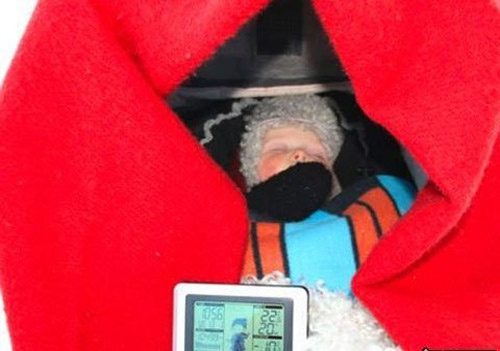Have you ever let your small children, especially infants, take a nap outside in the freezing cold, even when the temperature may drop below 0°C? Most parents in Northern Europe have no hesitation in doing so. For them, this is just “a normal day in the neighborhood”.
Wandering around this snow-covered city, you’ll easily spot rows of strollers outside cafes while parents enjoy their favorite beverages inside.

Children in Northern European countries like Sweden are often allowed to nap in strollers outdoors, even when temperatures drop below 0°C. (Photo: BBC)
“I believe it’s right to let children breathe fresh air as soon as possible, especially in winter when numerous illnesses lurk around… The kids seem to be healthier,” said Lisa Mardon, a mother of three living in Stockholm and working for a food distribution company.
Ms. Mardon has allowed all three of her children to nap outside since they were born. The youngest, Alfred, is just 2 years old and takes a nap outdoors once a day for about an hour and a half. When he was younger, he would nap like this twice a day.
Letting children sleep outdoors is not a new trend in Sweden. Ms. Mardon’s parents and grandparents did the same with their children back in the 1950s.
Currently, most daycare centers in Sweden allow children to rest outdoors. At Forskolan Orren, a kindergarten in the suburbs of Stockholm, all children sleep outside until they are 3 years old.
Brittmarie Carlzon, the school’s principal, revealed: “When the temperature drops to -15°C, we always use blankets over the strollers. During these days, we bring the strollers inside for a certain period while the kids sleep, but most of their nap time still occurs outdoors.”

A child sleeps in a stroller outdoors equipped with a monitoring device in weather as low as -10°C. (Photo: BBC)
A group of students at this kindergarten always plays and learns outdoors, from 9 AM to 3 PM every day. In the fresh air, the children do everything that other children typically do indoors and only go inside during lunchtime or when the weather is unusually cold.
Letting children nap outdoors is a common phenomenon across all Nordic countries. The principle behind this behavior is that children exposed to fresh air, whether in winter or summer, are less likely to catch colds or flu, and spending all day in a closed room with about 30 other children does not benefit them at all.
Many parents also believe that their children sleep better and more soundly outdoors. A Finnish researcher confirmed she has gathered survey evidence supporting this view.
“Young children clearly sleep longer outside than indoors (1.5 to 3 hours compared to 1 to 2 hours). It’s possible that the restricted movement from clothing has extended sleep duration, and the cold environment makes diapering more comfortable than warm weather,” said researcher Marjo Tourula.
According to Ms. Tourula’s research, -5°C is the most suitable temperature for napping outdoors, although some parents report having let their children sleep outside at -30°C.

A child sleeping in a stroller outside a café in Copenhagen, Denmark. (Photo: BBC)
Do children sleeping outdoors ultimately catch colds and flu less? According to pediatrician Margareta Blennow, reports from the Swedish Environmental Protection Agency have shown conflicting results. In some studies, they found that preschoolers spending many hours outdoors, not just sleeping, generally took fewer sick days than their peers who spent most of their time indoors. Other studies showed no differences at all.
Martin Jarnstrom, the head of one of the Ur och Skur kindergarten systems and a supporter of letting children nap outdoors, notes that despite the cold weather, children must always be kept warm by wearing wool and warm clothing, using warm sleeping bags, etc.
Swedes have a saying that goes, “There’s no such thing as bad weather, only bad clothing.” Therefore, when they see small children in other countries forced to stay indoors when the temperature drops below 0°C, Swedes might have coined another saying: “A little fresh air doesn’t hurt anyone.”
Official Advice from Finnish Experts
Regardless of the season, many children sleep overnight in strollers outdoors. Many children sleep better in the fresh air than in their bedrooms. Sleeping outdoors is not dangerous for a child. Mothers and babies can gradually start going outside when the child is 2 weeks old.
Even though most parents’ experiences are positive, experts and consultants remain cautious about this practice. Infants napping in freezing temperatures may have benefits but also carry risks.
Infants cannot regulate their body temperature as well as adults; a baby’s body temperature can drop four times faster than that of an adult! If care is not taken to keep the child warm, the risk of hypothermia can increase significantly.
Ensuring that children are easily accessible and observable is extremely important. Nordic countries like Finland, Denmark, and Iceland consistently rank among the happiest countries in the world with low crime rates. Nevertheless, the possibility of abduction should never be disregarded when leaving children outside alone.
With proper preparation and care, infants napping in freezing temperatures continue to be a long-standing tradition in Northern regions and show no signs of fading!
- The strange tribe hidden deep in the forest, cremating the dead and using their ashes as food
- Recently discovered “tear in the Earth” of 72km, the second-largest country in the world is engulfed in tsunami fears
- New discovery about “near-death experience”: Brain still active for up to 60 minutes after the heart stops


















































